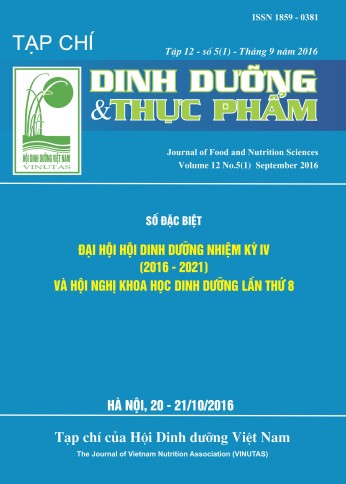STUDY ON EFFECTS OF TECHNICAL CONDITIONS ON LYCOPENE EXTRACTION FROM TOMATO
Main Article Content
Abstract
Lycopene, a biologically active, belonging to the carotenoid, is found in many fruits and vegetables such as tomato, watermelon, gac fruit, strawberry, papaya... Several studies have suggested that lycopene may have positive effects on human health, such as preventing cardiovascular diseases, protecting against some cancers and preventing UV induced erythema. In this study, lycopene was extracted from tomato paste in different technological conditions. The results showed that lycopene extraction efficiency reached 86.32% at suitable parameters of extraction process, such as the ratio of ethyl acetate/ tomato paste: 3/1, stirring speed of 300 rpm, at the temperature of 500C and time duration in 3h. Lycopene had been extracted 2 times gave the extraction efficiency of 91.32%.
Keywords
Lycopene, tomatoes, extraction, solvents, acetate ethyl
Article Details
References
2. Nunes I.L., and Mercadante A.Z. (2004). Production of lycopene crystals from tomato waste. Clinical Technology Alimentary Campinas, 24 (3), 440-447.
3. Kumar S.R., Sundar S.S., Afandi A., and Rahman S. (2013). Optimization of lycopene from Malaysian all season coloured fleshy fruits. Inter. Jou of Bio, Phar. And Allied Sci. 2(7), 1455-1467.
4. López Cervantes J., Sanchez-Machado D.I., Valenzuela-Sasnchez K.P., NúñezGastélum J.A., Ana Escárcega-Galaz A., and Roberto Rodríguez-Ramírez. (2014). Effect of solvents and method of stirring in extraction of lycopene, oleoresin and fatty acids from over-ripe tomato, Int. J. Food Sci. Nutr. 65(2), 187-193.
5. Fish W. W., Perkins-Veazie P., and Collins J. K. (2002). A quantitative assay for lycopene that utilizes reduced volumes of organic solvents. Journal of Food Composition and Analysis. 15, 309-317.
6. Strati I.F., and Oreopoulou V. (2011). Process optimization for recovery of carotenoids from tomato waste. Food Chem. 129, 747-52.
7. Mantanis G.I., Young R.A., and Rowell R.M. (1995). Swelling of compressed cellulose fiber webs in organic liquids, Cellulose. 2, 1-22.
8. Nunes I.L., and Mercadante A.Z. (2004). Production of lycopene crystals from tomato waste. Clinical Technology Alimentary Campinas. 24 (3), 440-447.
9. Kadian S.S and Sharma A. (2013). Effect of heat on the stability of tomato extract (lycopene). Inter. Jou of Bio, Phar. And Allied Sci. 2, 386-390.
Similar Articles
- Thi Chuyen HOANG, FOOD SAFETY SITUATION OF FOOD SERVICE FACILITIES IN HAGIANG CITY OF HAGIANG PROVINE , Vietnam Journal of Nutrition & Food: Vol. 13 No. 6 (2017)
You may also start an advanced similarity search for this article.


